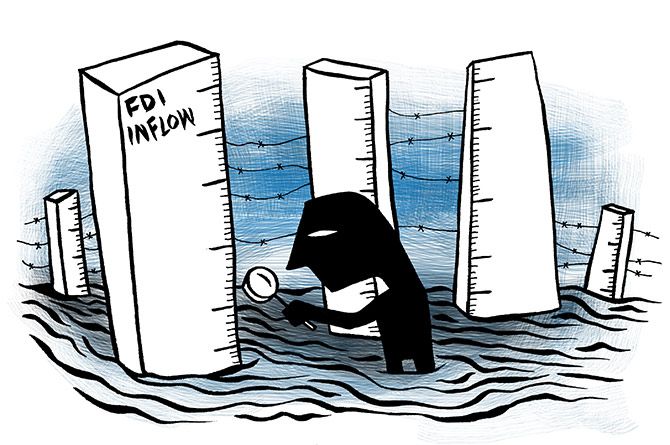'An explanation perhaps lies in the culture of revisions that has grown deep roots in the government data collection system,' notes A K Bhattacharya.
Illustration: Uttam Ghosh/Rediff.com

For three consecutive years -- from 2016-2017 to 2018-2019, foreign direct investment flows into India had recorded single digit growth. This was a surprise.
In the early years of the Narendra Modi government's first term, its ministers would tom-tom their achievement in securing a big jump in FDI flows into the country.
Indeed, FDI inflows rose by 25 per cent to $45 billion in 2014-2015 and jumped again by over 23 per cent to $56 billion in 2015-2016.
But after those two years, it seemed the Modi government was out of luck as far as FDI inflows were concerned.
The growth in 2016-2017 was just 8 per cent and it slid further to 1.2 per cent in 2017-2018 only to recover marginally to 1.7 per cent in 2018-2019, when total FDI inflows were estimated at $62 billion.
Coincidentally, this period also saw a deceleration in India's gross domestic product growth -- from 8.3 per cent in 2016-2017 to 7 per cent in 2017-2018 and further down to 6.1 per cent in 2018-2019.
The trend for FDI inflows, however, changed quite significantly in 2019-2020, the first year of the Modi government's second term.
Though GDP growth slumped to 4.2 per cent in 2019-2020, FDI inflows at over $73 billion staged a dramatic recovery -- a growth rate of 18 per cent.
What happened?
What could have changed that helped FDI inflows blossom in a year, when economic growth decelerated and exports recorded a decline?
A quick analysis of the FDI numbers for 2019-2020, compared with those for the previous couple of years, tells a slightly different story.
FDI inflows, as classified by the government, have four broad components -- FDI equity (through approvals by the Foreign Investment Promotion Board, clearance of FDI applications by the Reserve Bank of India either through the automatic route or by acquisition), equity capital flows into unincorporated bodies, reinvested earnings and other capital.
All these categories that constituted total FDI inflows saw an increase in 2019-2020, but the increases were more pronounced in two of them -- FDI equity and other capital.
Equity increased by about 13 per cent to about $50 billion, while other capital spurted by over 150 per cent to $8 billion.
Equity flows into unincorporated bodies also rose, but the amount was not that big at $1.2 billion. Reinvested earnings increased at a slower rate of just 3 per cent to $14 billion.
A slower pace of growth in reinvested earnings is worrying because it could reflect the relative lack of confidence on the part of the foreign investor to plough back its dividends or earnings into the existing venture.
Alternatively, it could also mean that the returns were not growing rapidly enough to allow higher reinvestment of such earnings.
But more puzzling is the 150 per cent rise in other capital, which largely consists of investment through instruments that are quasi-equity in nature like preference capital.
How did this category of investment go up so sharply in one year?
The government has clarified that the data in respect of other capital is estimated as average of the previous two years. In 2017-2018 and 2018-2019, other capital flows were estimated at $2.91 billion and $3.27 billion, respectively.
How did then 2019-2020 present such a dramatic improvement in the flow of other capital?
An explanation perhaps lies in the culture of revisions that has grown deep roots in the government data collection system.
When the data for other capital flows during 2018-2019 was first made public, the inflows amounted to $5.74 billion out of total FDI inflows of $64.37 billion.
A year later, the data for other capital for 2018-2019 was revised down to $3.27 billion. Consequently, total FDI inflows data too was pared down to about $62 billion.
Most likely, the data on other capital flows during 2019-2020 too would be revised down from the current estimate of $8.2 billion.
And the final figure for total FDI flows too would be revised down correspondingly and the growth rate at that time may not look as impressive as 18 per cent.
That apart, India's FDI inflows data for the last few years points to three more important trends.
One, India's direct FDI inflows from China have seen a drop in 2019-2020 even before the relations between the two countries became strained.
From a high of $1.23 billion in 2018-2019, FDI inflows from China dropped to 0.16 billion in 2019-2020. Not that Hong Kong gained as a result, with its FDI flows to India growing marginally from $0.59 billion to $0.69 billion in the same period.
The second trend is the gradual decline of Mauritius as a source of India's FDI.
Thanks to a double-tax avoidance treaty between India and Mauritius, FDI flows were being routed through that country in an attempt to take advantage of the lower tax rates there.
That treaty was modified in 2016, as per which the concessional tax rates were to be phased out in stages -- by 50 per cent from April 2017 and completely by April 2019.
The effect of that treaty modification has been the displacement of Mauritius as India's top source of FDI for the last two years.
Till then, Mauritius, for almost every year, would be the top country through which India's FDI flows would be routed.
In 2018-2019 and 2019-2020, Mauritius has ceded that position to Singapore. In India's FDI inflows in the last two years, Mauritius has accounted for about half of Singapore' share.
The third trend relates to the rise of the Cayman Islands, a tax haven.
FDI inflows from the Cayman Islands have been rising rapidly in the last few years -- from about $1 billion each in 2017-2018 and 2018-19 to $3.7 billion in 2019-2020.
Why have FDI inflows from the Cayman Islands gone up so sharply?
The Netherlands with its low tax rates is treated by many as a tax haven and FDI inflows from this European country have also been rising steadily -- from $3.87 billion in 2018-2019 to $6.7 billion in 2019-2020.
The government has announced that it would review its FDI policy in a comprehensive manner. Some of these trends deserve a closer study and the conclusions from that should help formulate a policy that can promote foreign investment in a sustainable manner.












 © 2025
© 2025